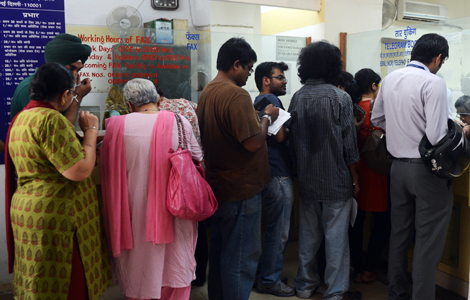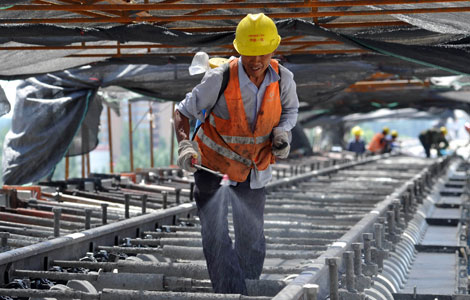Cooperating for posterity
Updated: 2013-07-15 07:26
By Zhang Zixuan (China Daily)
|
||||||||
|
A furniture craftsman with the Palace Museum works on a red sandalwood chair. Below: Many ancient Chinese paintings collected in the Palace Museum need elaborate restoration by repair masters. Zhang Fan / Xinhua |

|
A wooden sedan is on the list of items on a repair and rescue project at the Forbidden City's Palace Museum. A stool (below) is also waiting to be restored. Photos Provided to China Daily |

The Palace Museum in Beijing has a host of historical exhibits that take a lifetime to preserve and maintain. To keep these relics safe for posterity, the museum has stepped up efforts with a new partner. Zhang Zixuan reports from the Forbidden City.
Many imperial treasures gathering dust in the Forbidden City will soon see the light of day again, restored to their former glory under a new rescue and repair project - a cooperation between the Palace Museum and the Beijing Dongcheng district government, a deal sealed by a strategic agreement in January this year.
The new initiative is part of "The Safe Palace Museum" project.
"The Palace Museum is our lifeline so protecting it is our responsibility," says Dongcheng district director Niu Qingshan.
The cultural relics waiting to be repaired all belong to the Palace Museum collection, which fall into seven major categories: wooden furniture, royal lamps and lanterns, carts and palanquins, music instruments, walking sabers and swords, opera costumes, and Chinese silk tapestry.
Expert craftsmen, all heritage inheritors from traditional workshops such as the Beijing Opera Costume Factory and the Beijing Enamel Factory located in Dongcheng district, will be invited to restore the objects in the Palace Museum.
It will be the first time it is done on such a large scale.
"Dongcheng district is home to numerous crafts inheritors, many of whose teachers had worked in the Qing Dynasty (1644-1911) Court's manufacture office," says Palace Museum director Shan Jixiang. "They are very familiar with the objects they're going to repair."
The Palace Museum has a large collection of objects from the seven categories, Shan says.
The numbers are staggering, with 9,640 pieces of opera costumes, 1,448 lamps and lanterns, and some 300 carts and palanquins. Many have succumbed to the ravages of time and wear and tear. The repair project was supposed to take place several months later in the museum's 476,000-square-meter new branch at the north complex currently under construction, but museum director says it cannot wait.
Several rooms within the Hall of Consolation of Mothers (Ci Ning Gong) are now being used as temporary studios, and the work will move into the north complex at the end of this year when it is completed. Visitors will then be able to view the progress of the repairs.
"We cannot afford any delay since many of the masters are advanced in years," says Sun Ying, a state-level inheritor of opera costume making.
In 2003, Sun and the Beijing Opera Costume Factory reproduced more than 200 pieces of ritual equipment once used for royal weddings in the Palace of Earthly Tranquility (Kun Ning Gong).
Sun tells us that restoration is much more difficult than reproduction.
Shan says some of the repaired objects will be used. For example, the Palace of Longevity and Health (Shou Kang Gong) will be restored to its former glory, which means the Palace Museum will need a great number of lanterns and pieces of two-sided embroidery. More than 40 trainees are now working on them with the master craftsmen.
For craftsmanship that is already extinct in Beijing, museum experts are searching far and wide for the best heritage craftsmen from all over the country.
Wang Jianjiang is a sixth-generation craftsman specializing in the art of K'o-ssu silk tapestry. He was invited to Beijing for the project.
The 50-year-old says these tapestries were very precious in the past, so they are only used on the emperor's dragon robes.
"K'o-ssu is more difficult than embroidery. It is woven layer by layer to create a sculptured texture," says Wang, who was prepared for his task with a one-week training session on safety.
"Fabrics are very fragile. It can take up to three years to repair just one piece," says Miao Jianmin, the Palace Museum's director in the Cultural Heritage Conservation Department.
Museum Director Shan says that the whole restoration project will be well documented, so later generations will learn about the materials and techniques.
Contact the writer at zhangzixuan@chinadaily.com.cn.
(China Daily USA 07/15/2013 page9)

 US star sprinter fails drug test
US star sprinter fails drug test
 Protests erupt after verdict
Protests erupt after verdict
 Color Run in London promotes healthy living
Color Run in London promotes healthy living
 Urumqi residents hand in weapons
Urumqi residents hand in weapons
 Pool jammed in summer heat
Pool jammed in summer heat
 Last stop for the telegrams of India
Last stop for the telegrams of India
 Heavy rain, strong winds as Soulik heads inland
Heavy rain, strong winds as Soulik heads inland
 8 dead, 19 injured after bus leaves road in Jinghong
8 dead, 19 injured after bus leaves road in Jinghong
Most Viewed
Editor's Picks

|

|

|

|

|

|
Today's Top News
Four GSK China execs held for investigation
Asiana survivors coping with post traumatic stress
China's Q2 GDP growth slows to 7.5%
Canada mourns victims of train accident
Air crash students return to families
Snowden says he won't release harmful US data
Local governments face financing woes
Zimmerman not guilty
US Weekly

|

|








